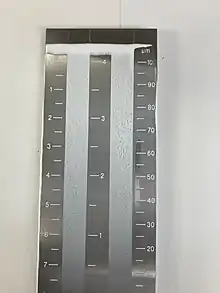A Hegman gauge, sometimes referred to as a grind gauge, grind gage, or grindometer, is an instrument which indicates the fineness of grind or the presence of coarse particles and agglomeration in a dispersion.[1] It is commonly used to determine how finely ground the particles of pigment (or other solid) dispersed in a sample of paint (or other liquid) are. This is important because many types of solid materials must be ground into finer particles in order to be dispersed in liquids.[2] The resulting properties of the dispersion vary based on the size of individual particles and the degree which they are dispersed.
The Hegman gauge usually consists of a stainless steel block with a series of very small parallel grooves machined into it. The grooves decrease in depth from one end of the block to the other, according to a scale stamped next to them. A typical Hegman gauge is 170mm by 65mm by 15mm, with a channel of grooves running lengthwise, 12.5mm across and narrowing uniformly in depth from 100 μm to zero and used to determine particle size.[3]
Use with paint
A Hegman gauge is used by placing a sample of paint at the deep end of the gauge and drawing the paint down with a flat edge along the grooves. Grind gages are sold with machined flat 'drawdown bars' specifically for this purpose. The paint fills the grooves, and the location where a regular, significant "pepperyness" in the appearance of the coating appears, marks the coarsest-ground dispersed particles.[3] This is the point where oversized particles start to appear in high density and determines the rating for that material.[4] The reading is taken from the scale marked next to the grooves, in dimensionless "Hegman units" (or National Standard units; NS) and/or mils or micrometres.[5] Hegman units are defined in terms of an inverted size scale as shown below:[6]



| Hegman Units | Mils | Microns |
|---|---|---|
| 0 | 4.0 | 101.6 |
| 1 | 3.5 | 88.9 |
| 2 | 3.0 | 76.2 |
| 3 | 2.5 | 63.5 |
| 4 | 2 | 50.8 |
| 5 | 1.5 | 38.1 |
| 6 | 1 | 25.4 |
| 7 | 0.5 | 12.7 |
| 8 | 0 | 0 |
A lesser-used scale, North (or PCU), is also occasionally employed in the paint industry. Like the Hegman scale, this is also inverted compared to the value in microns:
| Microns | North units |
|---|---|
| 0 | 100 |
| 10 | 90 |
| 20 | 80 |
| 30 | 70 |
| 40 | 60 |
| 50 | 50 |
| 60 | 40 |
| 70 | 30 |
| 80 | 20 |
| 90 | 10 |
| 100 | 0 |
Determining the fineness of a paint's grind is important, because too coarse a grind may reduce the paint's color uniformity, gloss, and opacity.[7] The Hegman gauge is widely used for this purpose because it requires minimal skill and only a few seconds' work.[3]
Other uses
Grind gauges are used in a variety of fields, including; food, pharmaceutical, plastic and many others. In all of these fields, grind gauges are utilized to produce, store, and apply dispersion products.
Sizes
Hegman gauges are commonly available in the following ranges: 0 to 100 micrometres, 0 to 50 micrometres, 0 to 25 micrometres, 0 to 15 micrometres, and 0 to 10 micrometres.
References
- ↑ Koeler, Paint and Coating Testing Manual, p. 743, ISBN 0-8031-2060-5
- ↑ "ASTM D1210 - 05(2014) Standard Test Method for Fineness of Dispersion of Pigment-Vehicle Systems by Hegman-Type Gage".
- 1 2 3 Robert B. McKay, Technological Applications of Dispersions, p. 43 (citing ASTM D1210-79 (1988)). Marcel Dekker, Inc., 1994.
- ↑ "ASTM D1316 - 20 Standard Test Method for Fineness of Grind of Printing Inks by the NPIRI Grindometer".
- ↑ Eric Kissa, Dispersions: Characterization, Testing, and Measurement, p. 243. Marcel Dekker, Inc., 1999.
- ↑ D. Doubleday and A. Barkman, "Reading the Hegman Grind Gauge" Paint, Oil and Chemical Review June 22, 113 1950 pp 34-39, http://www.gardco.com/pages/dispersion/fg/Hegman%20Article.pdf
- ↑ Peter A. Ciullo, Industrial Minerals and Their Uses: A Handbook and Formulary, pp. 155–56. Noyes Publication 1996.
Bibliography
- Koleske. Paint and coating testing manual : fourteenth edition of the Gardner-Sward handbook (14th ed.). ASTM. ISBN 0-8031-2060-5.